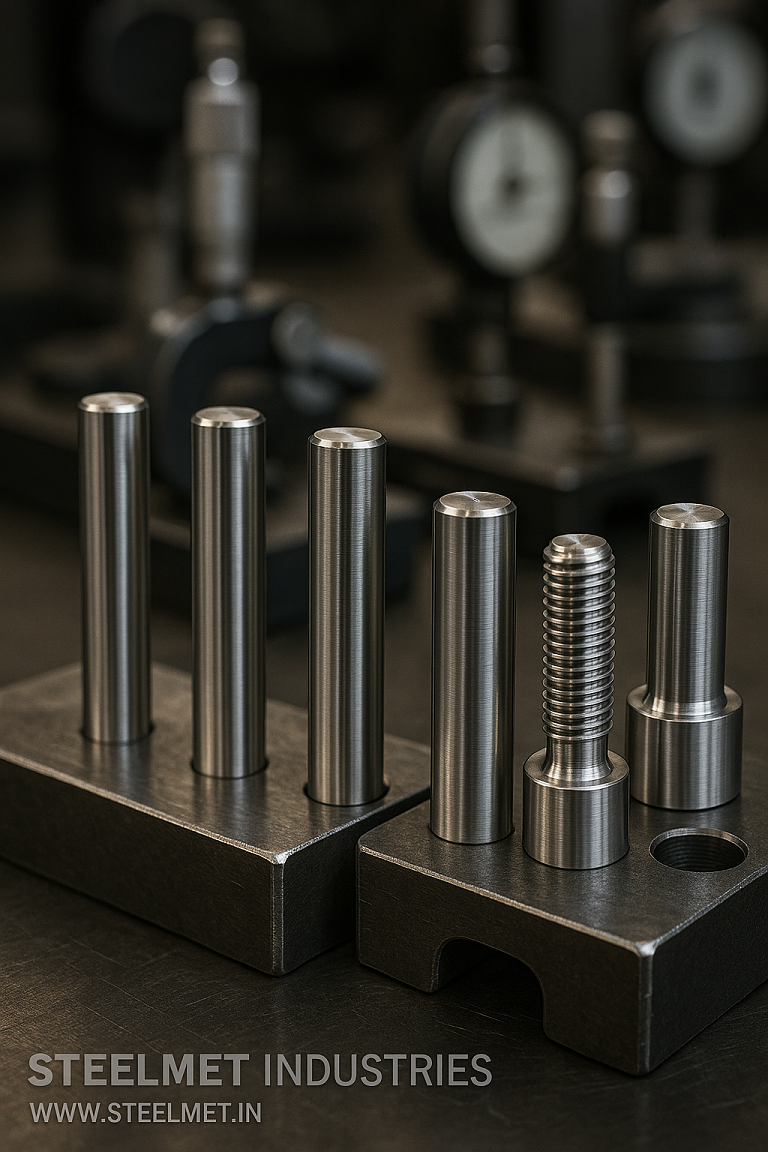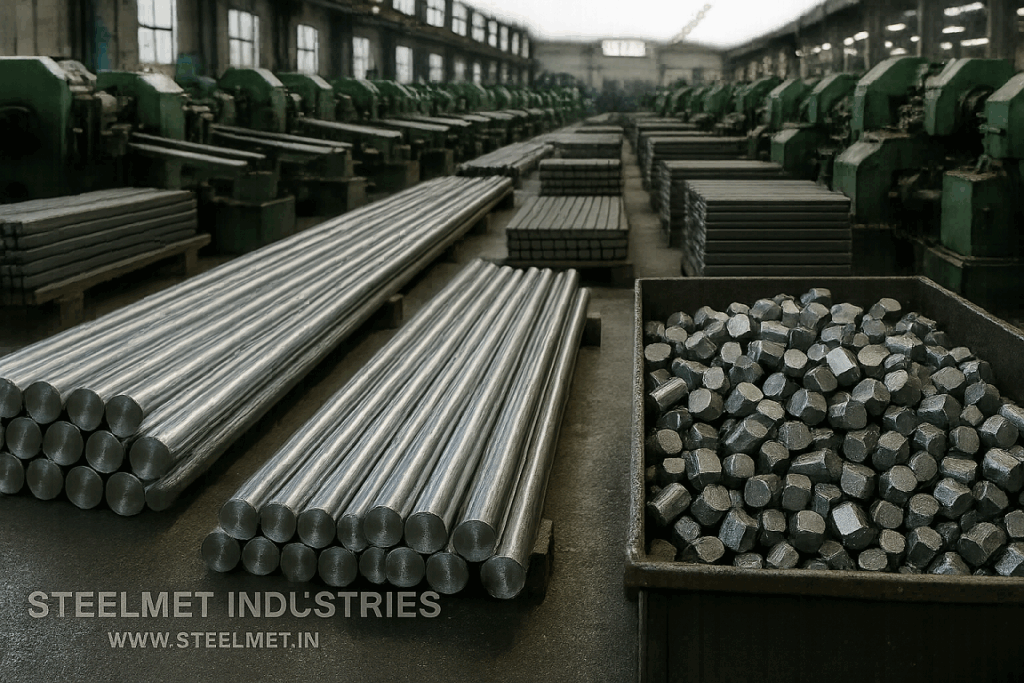Bright Steel Bars for Fasteners, Bolts, Nuts & Precision Hardware
Fasteners and precision hardware require consistent diameters, excellent surface finish and predictable material behaviour to support cold forming, thread rolling, high-speed turning and reliable heat treatment. Bright steel bars reduce scrap, extend die life, and ensure repeatable mechanical properties for high-volume and critical-service fasteners.

Bright bar stock and fastener blanks staged for inspection — ready for cold forging and precision machining.
Primary Fastener Applications
- Cold-headed bolts, hex bolts, flange bolts and carriage bolts
- High-strength stud bolts for flanged joints and pressure systems
- Machine screws, set screws and precision threaded components
- Nuts, flange nuts, threaded bushings and insert components
- Threaded rods, tie-rods and long studs
- Custom turned and special fasteners requiring tight tolerances
Product Families
Cold-Forged Fasteners & High-Volume Production Parts
Cold-heading utilises bright bars for blanking and forming heads with superior material flow. Material consistency, surface quality and controlled ductility determine die life, heading quality and final mechanical properties.
Heat-Treated Bolts & Studs (Q&T / Case-Hardened / High-Tensile)
High-strength bolts and studs depend on controlled chemistry and reliable quench & temper or case-hardening cycles to achieve specified tensile classes and fatigue performance.
Precision Nuts, Threaded Bushings & Insert Components
Internally threaded parts and inserts require concentric bores, consistent hardness and smooth surface condition to ensure reliable thread performance and torque characteristics.
Special Fasteners & Custom Turned Hardware
Shoulder bolts, long studs, grooved fasteners and alloy fasteners are typically machined or forged from bright bars selected for specific mechanical and thermal response characteristics.
Why choose bright bars for fasteners
- Uniform diameter and low surface defect rates increase die life and reduce scrappage in cold-heading operations.
- Free-cutting bright bars reduce cycle times and tool wear during turning and threading operations.
- Predictable chemistry supports consistent quench & temper or case-hardening cycles for tensile-class fasteners.
- Better straightness and roundness improve thread-rolling yields and reduce thread rejection rates.
Real-world use case
Example: A fastener house switching to EN1A (12L14) bright bars for small machine screws reduced machining cycle time and tool costs by over 15%, while using EN19/4140 as a starting bar for high-tensile studs allowed consistent production of 10.9-equivalent bolts after Q&T with low rejection rates for thread and strength tests.
Quick decision pointers
- For high-volume cold-heading: use free-cutting bright bars such as EN1A/12L14 with controlled elongation and ductility.
- For high-tensile studs and structural fasteners: select EN19/4140 or EN24/4340 and specify Q&T and tensile class requirements.
- For nuts and threaded inserts: prefer materials with good machinability and consistent hardness; EN1A or mild carbon grades often suffice.
- For special alloy fasteners: choose grades and heat treatments that match corrosion, temperature and strength requirements of the application.
Failure-prevention and quality notes
- Control bar draw stress and microstructure for cold-heading applications—excessive residual stresses can cause head cracking.
- For thread-rolled parts, specify OD tolerance class to ensure correct pitch diameter after rolling rather than excessive machining allowance.
- Define hydrogen embrittlement prevention steps (baking after plating, appropriate pre-cleaning) for high-strength, plated fasteners.
- Specify certification requirements (chemical analysis, tensile test reports, hardness) for each delivery batch of fastener-grade bright bars.
Standards & Equivalents (Table 1)
| IS | BS970 | AISI / SAE | DIN / EN | JIS | GOST | GB |
|---|---|---|---|---|---|---|
| EN1A / EN1AL | 230M07 | 12L14 | 11SMnPb30 | SUM22 | 10ЮТ | Y12Pb |
| C45 | EN8 | 1045 | C45E / 1.1191 | S45C | 45 | 45# |
| EN9 | 070M55 | 1055 | C55 / 1.0535 | S55C | 55 | 55# |
| EN19 | 708M40 | 4140 | 42CrMo4 / 1.7225 | SCM440 | 40Х | 42CrMo |
| EN24 | 817M40 | 4340 | 34CrNiMo6 / 1.6582 | SNCM447 | 40ХН2МА | 34CrNiMo6 |
Grade Selection, Performance & Heat Treatment (Table 2)
| Grade | Typical Application in Fasteners | Performance Indicators | Typical Heat Treatment Route |
|---|---|---|---|
| EN1A / EN1AL (12L14) | Primary choice for small to medium-sized turned fasteners and cold-headed parts where high machining speed, consistent chip formation and excellent surface finish are required. | Machinability: High | Hardenability: Low | Wear Resistance: Low | Fatigue Strength: Low/Moderate | Supplied as-drawn; usually used in the turned/finished state. Minimal heat treatment; can be stress relieved if required. |
| C45 / EN8 (1045) | Used for studs, medium-strength bolts and larger-turning applications where a balance of strength and machinability is required; suitable for parts requiring subsequent Q&T or induction hardening. | Machinability: Medium | Hardenability: Low/Medium | Wear Resistance: Moderate | Fatigue Strength: Moderate | Normalize or Q&T depending on required tensile class; induction hardening on selected surfaces possible. |
| EN19 (4140 / 42CrMo4) | Common starting material for high-strength studs, structural fasteners and critical bolts that must meet high tensile and toughness requirements after quench & temper. | Machinability: Medium | Hardenability: Good | Wear Resistance: High | Fatigue Strength: High | Quench & Temper to meet specified tensile class (e.g., 10.9 equivalent); post-heat-treatment straightness controls are critical. |
| EN24 (4340 / 34CrNiMo6) | Used for ultra-high strength fasteners, specialist studs and components exposed to high shock loads or cyclic fatigue where superior toughness and fatigue life are required. | Machinability: Medium/Low | Hardenability: Excellent | Wear Resistance: Very High | Fatigue Strength: Very High | Quench & Temper; may use calibrated temper sequences for consistent tensile and impact properties. |
| EN9 / C55 (1055) | Used for shear pins, heavy bolts and components where higher through-hardness is required; common in load-shedding features and sacrificial components. | Machinability: Medium/Low | Hardenability: Good | Wear Resistance: High | Fatigue Strength: Moderate/High | Quench & Temper or through-hardening depending on section and application; temper to required ductility for shear applications. |
Inspection & manufacturing checklist
- Specify OD tolerance class for blanks aimed at thread-rolling; ensure pitch-diameter allowances are calculated for rolled threads.
- For cold-headed parts, request material elongation and reduction-of-area data to verify formability.
- Include hydrogen embrittlement mitigation steps after plating: post-plating baking at specified temperature/time.
- Require batch chemical and mechanical test certificates for high-strength fasteners; include NDT where critical.
Frequently Asked Questions
Which bright bar is best for cold-heading small bolts?
EN1A / 12L14 is commonly used for cold-heading small bolts and screws due to its free-cutting properties and consistent heading performance.
How do I specify material for 10.9 or 12.9 equivalent bolts?
Specify an alloy bright bar such as EN19 (4140) or EN24 (4340) with a defined quench & temper route and tensile/impact requirements to meet 10.9 / 12.9 classes; include testing requirements in purchase orders.
What measures prevent thread failures after plating?
Implement post-plating hydrogen relief baking, control plating current density, and verify thread geometry after plating. Selecting compatible base metals and pre-treatment reduces embrittlement risk.
Contact for Fastener Material & Supply
For blank supply, heading stock, high-strength stud production, customised tolerances or long-term sourcing of bright bars for fasteners:
Request a Quote / Technical Discussion
Related: Cold-Forged Fasteners — Heat-Treated Bolts & Studs — Precision Nuts & Inserts

